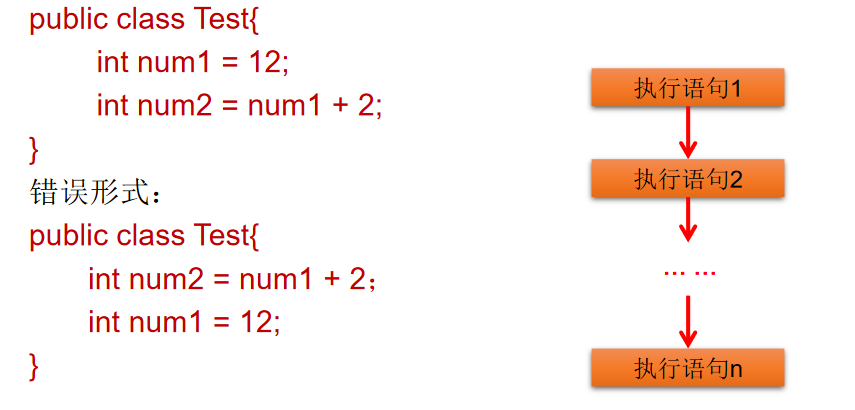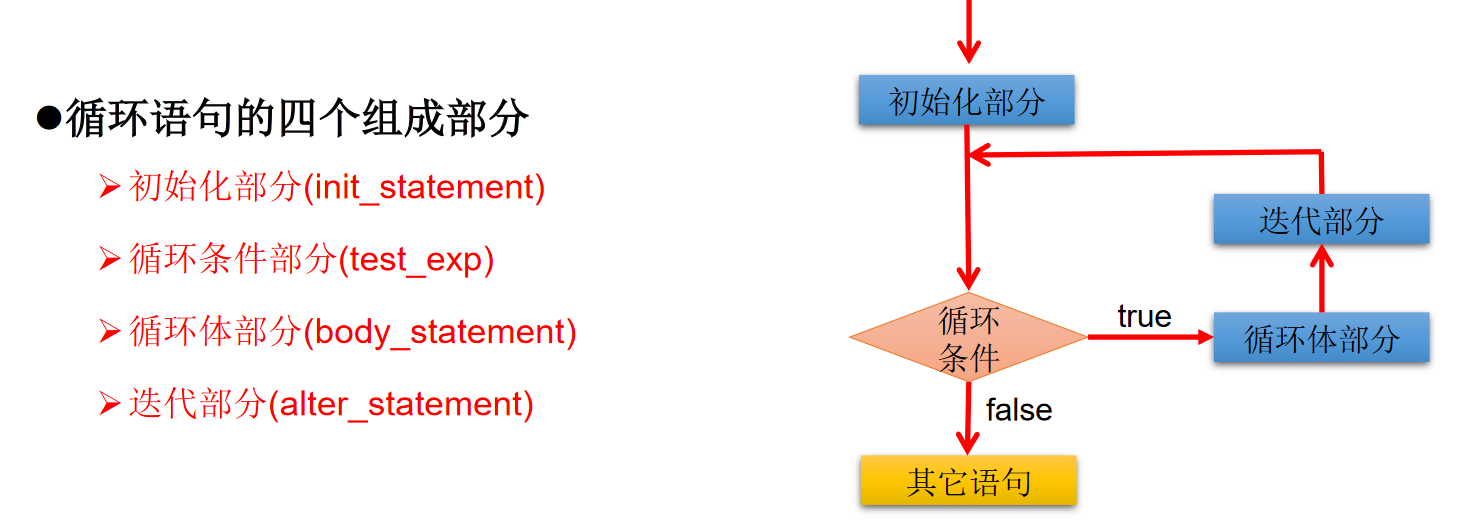01、 程序流程控概述
流程控制语句是用来控制程序中各语句执行顺序的语句,可以把语句组合成能完成一定功能的小逻辑模块。
其流程控制方式采用结构化程序设计中规定的三种基本流程结构,即:
- 顺序结构
- 分支结构
- 循环结构
1、顺序结构
程序从上到下逐行地执行,中间没有任何判断和跳转。
2、分支结构
- 根据条件,选择性地执行某段代码。
- 有if…else和switch-case两种分支语句
3、循环结构
- 根据循环条件,重复性的执行某段代码。
- 有while、do…while、for三种循环语句。
- 注:JDK1.5提供了foreach循环,方便的遍历集合、数组元素。
02、 顺序结构
03、分支语句
2.1、分支语句1:if-else结构
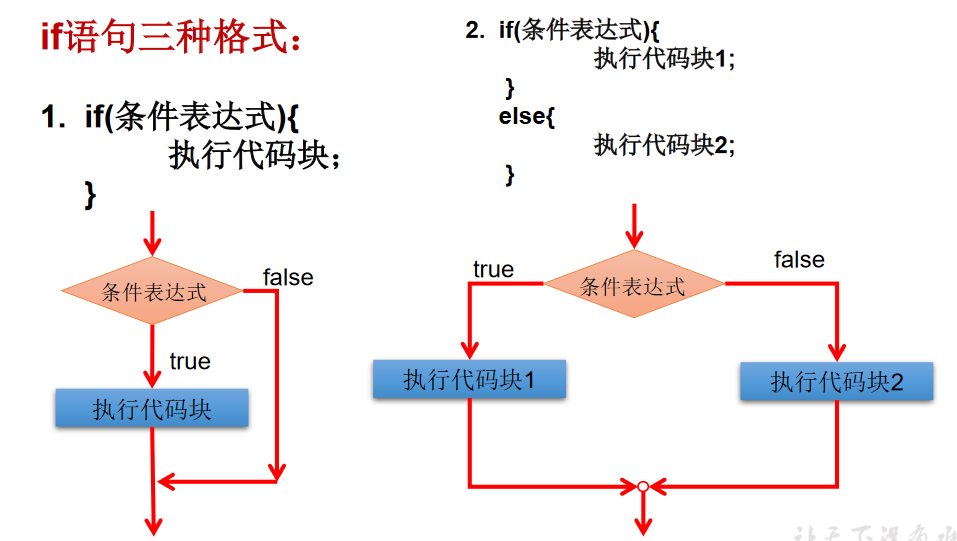
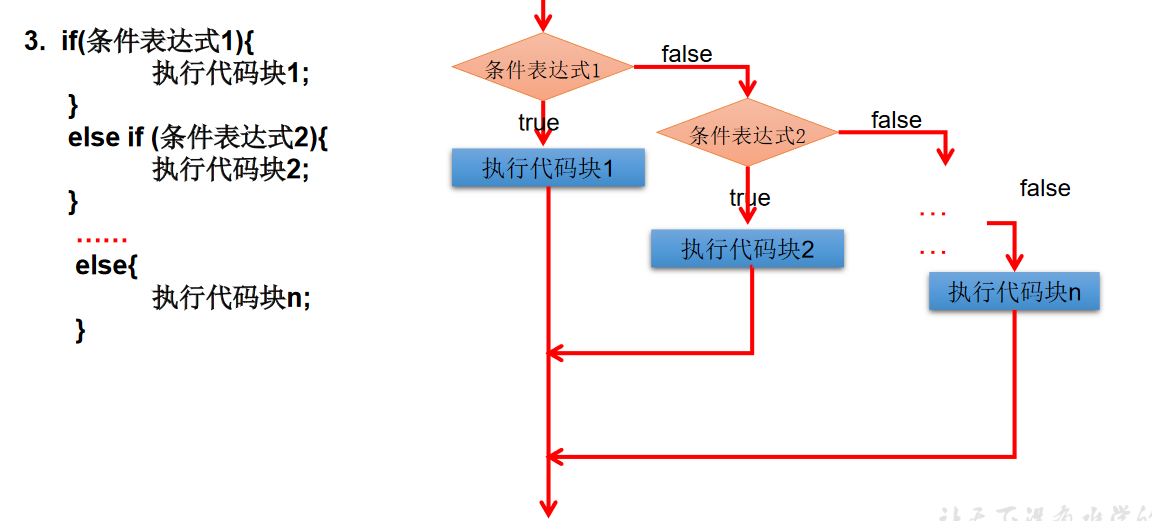
1、if-else使用说明:
条件表达式必须是布尔表达式(关系表达式或逻辑表达式)、布尔变量;
语句块只有一条执行语句时,一对{}可以省略,但建议保留;
if-else语句结构,根据需要可以嵌套使用;
当if-else结构是“多选一”时,最后的else是可选的,根据需要可以省略;
当多个条件是“互斥”关系时,条件判断语句及执行语句间顺序无所谓当多个条件是“包含”关系时,“小上大下/ 子上父下”。
2、练习
/*分支结构中的if-else(条件判断结构)一、三种结构第一种:if(条件表达式){执行表达式}第二种:if(条件表达式){执行表达式1}else{执行表达式2}第三种:if(条件表达式){执行表达式1}else if{执行表达式2}else if(条件表达式){执行表达式3}...else{执行表达式n}*/class IfTest{public static void main(String[] args){//举例1int heartBeats = 75;if(heartBeats < 60 || heartBeats > 100){System.out.println("需要进一步做检查");}System.out.println("检查结束");//举例2int age = 23;if(age < 18){System.out.println("你还可以看动画片");}else{System.out.println("你可以看科技电影了");}//举例3if(age < 0){System.out.println("你输入的数据不合适");}else if(age < 18){System.out.println("你还是个青少年");}else if(age < 35){System.out.println("你还是个青壮年");}else if(age < 60){System.out.println("你还是个中年");}else if(age < 120){System.out.println("你进入老年了");}else{System.out.println("你成仙了");}}}
2.1.1、输入语句
/*如何从键盘获取不同类型的变量,需要使用Scanner类具体步骤:1.导包:import java.util.Scanner;2.Scanner的实例化;3.调用Scanner类的相关方法,来获取指定的变量。*/import java.util.Scanner;class IFTest{public static void main(String[] args){//声明一个ScannerScanner scan = new Scanner(System.in);int num = scan.nextInt();System.out.println(num);}}
/*如何从键盘获取不同类型的变量,需要使用Scanner类具体步骤:1.导包:import java.util.Scanner;2.Scanner的实例化;3.调用Scanner类的相关方法,来获取指定的变量。*/import java.util.Scanner;class IFTest{public static void main(String[] args){//Scanner实例化Scanner scan = new Scanner(System.in);System.out.println("请输入你的姓名:");String name = scan.next();System.out.println(name);System.out.println("请输入你的年龄:");int age = scan.nextInt();System.out.println(age);System.out.println("请输入你的体重:");double weight = scan.nextDouble();System.out.println(weight);System.out.println("你是否单身?(true/false)");boolean isLive = scan.nextBoolean();System.out.println(isLive);//char型的获取,Scanner没有提供相关方法,只能获取一个字符串System.out.println("请输入你的性别:(男/女)");String TF = scan.next();char TFChar = TF.charAt(0);System.out.println(TFChar);}}
1、练习1
/*岳小鹏参加Java考试,他和父亲岳不群达成承诺:如果:成绩为100分时,奖励一辆BMW;成绩为(80,99]时,奖励一台iphone xs max;当成绩为[60,80]时,奖励一个iPad;其它时,什么奖励也没有。请从键盘输入岳小鹏的期末成绩,并加以判断说明:1.else结构是可选的。2.针对于条件表达式:① 如果多个条件表达式之间的关系是“互斥”关系(或没有交集的关系),哪个判断和执行语句声明在上面还是下面,无所谓;② 如果多个条件表达式之间是有交集的关系,需要根据实际情况,需要考虑实际情况,考虑清楚应该将哪个结构声明在上面。③ 如果多个条件表达式之间有包含的关系,通常情况下,需要将范围小的声明在范围大的上面。否则,范围小的就没机会运行。*/import java.util.Scanner;class IFTest02{public static void main(String[] args){Scanner scan = new Scanner(System.in);System.out.println("请输入岳小鹏的成绩:");int score = scan.nextInt();if(score == 100){System.out.println("奖励一辆BMW");}else if(score >80 && score <=99){System.out.println("奖励一台iphone xs max");}else if(score >= 60 && score <= 80){System.out.println("奖励一个iPad");}else{System.out.println("奖励?学习去!!!");}}}
2、练习2
/*编写程序:由键盘输入三个整数分别存入变量num1、num2、num3,对它们进行排序(使用if-else if-else),并且从小到大输出。*/import java.util.Scanner;class Sorting{public static void main(String[] args){//Scanner实例化Scanner scan = new Scanner(System.in);System.out.println("请输入第一个整数:");int num1 = scan.nextInt();System.out.println("请输入第二个整数:");int num2 = scan.nextInt();System.out.println("请输入第三个整数:");int num3 = scan.nextInt();int MaxNumber = 0;if(num1 >= num2 ){if(num3 >= num1){System.out.println(num2 + "," + num1 + "," + num3);}else if(num3 <= num2){System.out.println(num3 + "," + num2 + "," + num1);}else{System.out.println(num2 + "," + num3 + "," + num1);}}else{if(num3 >= num2){System.out.println(num1 + "," + num2 + "," + num3);}else if(num3 <= num1){System.out.println(num3 + "," + num1 + "," + num2);}else{System.out.println(num1 + "," + num3 + "," + num2);}}}}
3、练习3
/*我家的狗5岁了,5岁的狗相当于人类多大呢?其实,狗的前两年每一年相当于人类的10.5岁,之后每增加一年就增加四岁。那么5岁的狗相当于人类多少年龄呢?应该是:10.5 + 10.5 + 4 + 4 + 4 = 33岁。如果用户输入负数,请显示一个提示信息。*/import java.util.Scanner;class DogYear{public static void main(String[] args) {Scanner scan = new Scanner(System.in);System.out.println("请输入狗的年龄:");double Dyear = scan.nextDouble();if(Dyear <= 2 && Dyear > 0){System.out.println("狗的年龄等同于人的:" + Dyear * 10.5);}else if(Dyear <= 0){System.out.println("你输入的不正确。");}else{double number = 2 * 10.5 + (Dyear - 2) * 4;System.out.println("狗的年龄等同于人的:" + number);}}}
4、练习4
/*假设你想开发一个玩彩票的游戏,程序随机地产生一个两位数的彩票,提示用户输入一个两位数,然后按照下面的规则判定用户是否能赢。1)如果用户输入的数匹配彩票的实际顺序,奖金10 000美元。2)如果用户输入的所有数字匹配彩票的所有数字,但顺序不一致,奖金3 000美元。3)如果用户输入的一个数字仅满足顺序情况下匹配彩票的一个数字,奖金1 000美元。4)如果用户输入的一个数字仅满足非顺序情况下匹配彩票的一个数字,奖金500美元。5)如果用户输入的数字没有匹配任何一个数字,则彩票作废。提示:使用(int)(Math.random() * 90 + 10)产生随机数。Math.random() : [0,1) * 90 [0,90) + 10 [10,100)[10,99]*/import java.util.Scanner;class CaiTest{public static void main(String[] args){//1、随机产生一个两位数//System.out.println(Math.random());//产生[0,1)int number = (int)(Math.random()*90 + 10);//得到[10,99],即[10,100)//System.out.println(number);int numberShi = number/10;int numberGe = number%10;//2、用户输入一个两位数Scanner input = new Scanner(System.in);System.out.print("请输入一个两位数:");int guess = input.nextInt();int guessShi = guess/10;int guessGe = guess%10;if(number == guess){System.out.println("奖金10 000美元");}else if(numberShi == guessGe && numberGe == guessShi){System.out.println("奖金3 000美元");}else if(numberShi==guessShi || numberGe == guessGe){System.out.println("奖金1 000美元");}else if(numberShi==guessGe || numberGe == guessShi){System.out.println("奖金500美元");}else{System.out.println("没中奖");}System.out.println("中奖号码是:" + number);}}
6、练习5
/*大家都知道,男大当婚,女大当嫁。那么女方家长要嫁女儿,当然要提出一定的条件:高:180cm以上;富:财富1千万以上;帅:是。如果这三个条件同时满足,则:“我一定要嫁给他!!!”如果三个条件有为真的情况,则:“嫁吧,比上不足,比下有余。”如果三个条件都不满足,则:“不嫁!”*/import java.util.Scanner;class GaoFuTest{public static void main(String[] args){Scanner scan = new Scanner(System.in);System.out.println("请输入你的身高:(cm)");int height = scan.nextInt();System.out.println("请输入你的财富:(千万)");double weight = scan.nextDouble();// System.out.println("请输入你是否帅:(true/false)");// boolean isHandSome = scan.nextBoolean();// if(height >= 180 && weight >= 1 && isHandSome){// System.out.println("我一定要嫁给他!!!");// }else if(height >= 180 || weight >= 1 || isHandSome){// System.out.println("嫁吧,比上不足,比下有余。");// }else{// System.out.println("不嫁!");// }//方式二System.out.println("请输入你是否帅: (是or否)");String isHandsome = scan.next();if(height >= 100 && weight >= 1 && isHandsome.equals("是")){System.out.println("我一定要嫁给他!!!");}else if(height >= 180 || weight >= 1 || isHandsome.equals("是")){System.out.println("嫁吧,比上不足,比下有余。");}else{System.out.println("不嫁!");}}}
2.2、 分支语句2:switch-case结构
注意: switch结构中的表达式,只能是如下的六种数据类型之一:byte、short、char、int、枚举类型(JDK5.0)、String类型(JDK7.0)
不能是:long,float,double,boolean。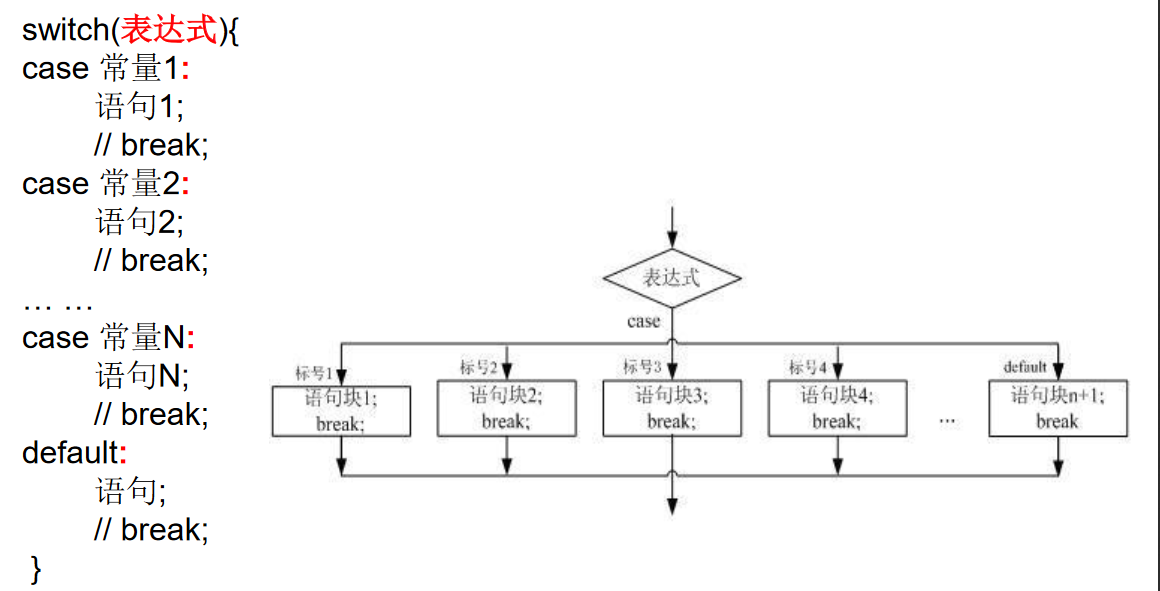
/*分支结构之二:switch-case1.格式switch(表达式){case 常量1:执行语句1;//break;case 常量2:执行语句2;//break;...default:执行语句n://break;}2.说明:① 根据switch表达式中的值,依次匹配各个case中的常量。一旦匹配成功,进入相应case结构中,执行相关语句。当调用完执行语句后,则仍然继续向下执行其他case语句,直到遇到break关键字或末尾结束为止。② break, 可以使用switch-case结构中,表示一旦执行到此关键字,就跳出switch-case结构。③ switch结构中的表达式,只能是如下的六种数据类型之一:byte、short、char、int、枚举类型(JDK5.0)、String类型(JDK7.0)④ case 之后之能声明常量。不能声明范围。⑤ break关键字是可选的。⑥ default:相当于if-else结构中的else。default 结构是可选的,而且位置是灵活的。*/class SwitchTest{public static void main(String[] args){int number = 2;switch(number){case 0:System.out.println("zero");break;case 1:System.out.println("one");break;case 2:System.out.println("twe");break;case 3:System.out.println("three");break;default:System.out.println("other");break;}//*********************************//运行报错,不能运行boolean类型/* boolean isHandSome = true;switch(isHandSome){case true:System.out.println("可乐吗??");break;case false:System.out.println("薯条吗??");break;default:System.out.println("输入有误!!!");}*///*********************************String season= "summer";switch(season) {case"spring":System.out.println("春暖花开");break;case"summer":System.out.println("夏日炎炎");break;case"autumn":System.out.println("秋高气爽");break;case"winter":System.out.println("冬雪皑皑");break;default:System.out.println("季节输入有误");break;}//**************************************//运行报错/* int age = 10;switch(age){case age > 18:System.out.println("成年了");break;default:System.out.println("未成年");} */}}
1、练习1
/*使用switch 把小写类型的char型转为大写。只转换a, b, c, d, e. 其它的输出“other”。提示:String word = scan.next(); char c = word.charAt(0); switch(c){}*/import java.util.Scanner;class SwitchCaseTest1{public static void main(String[] args) {Scanner scan = new Scanner(System.in);String word = scan.next();char c = word.charAt(0);switch(c){case 'a':System.out.println("A");break;case 'b':System.out.println("B");break;case 'c':System.out.println("C");break;case 'd':System.out.println("D");break;case 'e':System.out.println("E");break;default:System.out.println("other");}}}
2、练习2
/*对学生成绩大于60分的,输出“合格”。低于60分的,输出“不合格”。说明:如果switch-case语句中多个相同语句,可以进行合并。*/class SwitchTest1{public static void main(String[] args){int score = 78;//方案一switch(score / 10){case 0:case 1:case 2:case 3:case 4:case 5:System.out.println("不合格");break;case 6:case 7:case 8:case 9:case 10:System.out.println("合格");break;}//更优的解法switch(score /60){case 0:System.out.println("不及格");break;case 1:System.out.println("合格");break;}}}
3、练习3
/*根据用于指定月份,打印该月份所属的季节。3,4,5 春季6,7,8 夏季9,10,11 秋季12, 1, 2 冬季*/class MonthTest{public static void main(String[] args){int month = 6;switch(month){case 12:case 1:case 2:System.out.println("冬季");break;case 3:case 4:case 5:System.out.println("春季");break;case 6:case 7:case 8:System.out.println("夏季");break;case 9:case 10:case 11:System.out.println("秋季");break;}}}
4、练习4
/*编写程序:从键盘上输入2020年的“month”和“day”,要求通过程序输出输入的日期为2019年的第几天。2 15 : 31 + 155 7: 31 + 28 +31 +30 + 7...说明:break在switch-case中是可选的。*/import java.util.Scanner;class DayTest{public static void main(String[] args) {Scanner scan = new Scanner(System.in);System.out.println("请输入2020年的month");int month = scan.nextInt();System.out.println("请输入2020年的day");int day = scan.nextInt();//定义一个变量来保存天数int sumDays = 0;switch(month){case 12:sumDays += 30;case 11:sumDays += 31;case 10:sumDays += 30;case 9:sumDays += 31;case 8:sumDays += 31;case 7:sumDays += 30;case 6:sumDays += 31;case 5:sumDays += 30;case 4:sumDays += 31;case 3:sumDays += 29;case 2:sumDays += 31;case 1:sumDays += day;}System.out.println("2020年" + month + "月" + day + "日是当年的第" + sumDays + "天");}}
5、练习5
/*从键盘分别输入年、月、日,判断这一天是当年的第几天注:判断一年是否是闰年的标准:1)可以被4整除,但不可被100整除或2)可以被400整除(year % 4 == 0 && year % 100 != 0) || year %400 == 0)说明:1凡是可以使用switch-case的结构,都可以转换为if-else。反之,不成立。2.我们写分支结构时,当发现既可以使用switch-case,〔(同时,switch中表达式的取值情况不太多),又可以使用,我们优先选择使用switch-case。原因:switch-case执行效率稍高。*/import java.util.Scanner;class YearDayTest{public static void main(String[] args) {Scanner scan = new Scanner(System.in);System.out.println("请输入year");int year = scan.nextInt();System.out.println("请输入month");int month = scan.nextInt();System.out.println("请输入day");int day = scan.nextInt();//定义一个变量来保存天数int sumDays = 0;switch(month){case 12:sumDays += 30;case 11:sumDays += 31;case 10:sumDays += 30;case 9:sumDays += 31;case 8:sumDays += 31;case 7:sumDays += 30;case 6:sumDays += 31;case 5:sumDays += 30;case 4:sumDays += 31;case 3://判断是否为闰年if((year % 4 == 0 && year % 100 != 0) || year %400 == 0){sumDays += 29;}else{sumDays += 28;}case 2:sumDays += 31;case 1:sumDays += day;}System.out.println(year + "年" + month + "月" + day + "日是当年的第" + sumDays + "天");}}
6、练习六
/*编写一个程序,为一个给定的年份找出其对应的中国生肖。中国的生肖基于12年一个周期,每年用一个动物代表:rat、ox、tiger、rabbit、dragon、snake、horse、sheep、monkey、rooster、dog、pig。提示:2019年:猪2019 % 12 == 3*/import java.util.Scanner;class ZodiacSignTest{public static void main(String[] args){Scanner scan = new Scanner(System.in);System.out.println("请输入年份:");int year = scan.nextInt();switch (year % 12){case 1:System.out.println("rooster");break;case 2:System.out.println("dog");break;case 3:System.out.println("pig");break;case 4:System.out.println("rat");break;case 5:System.out.println("ox");break;case 6:System.out.println("tiger");break;case 7:System.out.println("rabbit");break;case 8:System.out.println("dragon");break;case 9:System.out.println("snake");break;case 10:System.out.println("horse");break;case 11:System.out.println("sheep");break;case 12:System.out.println("monkey");break;}}}
04、循环结构
1、循环结构
在某些条件满足的情况下,反复执行特定代码的功能
2、循环语句分类
- for 循环
- while 循环
- do-while 循环
4.1、for循环
语法格式for(①初始化部分;②循环条件部分;④迭代部分){③循环体部分;}执行过程:①-②-③-④-②-③-④-②-③-④-.....-②说明:②循环条件部分为boolean类型表达式,当值为false时,退出循环①初始化部分可以声明多个变量,但必须是同一个类型,用逗号分隔④可以有多个变量更新,用逗号分隔

/*For循环结构的使用一、循环结构的四个要素① 初始化条件② 循环条件③ 循环体④ 迭代条件二、for循环的结构for(①;②;④){③}*/class ForTest{public static void main(String[] args){for(int i=1;i <= 5 ;i++){System.out.println("Hello World!");}//练习:int num = 1;for(System.out.print('a');num <= 3;System.out.print('c'),num++){System.out.print('b');}//遍历100以内的偶数,获取所有偶数的和,输出偶数的个数int sum = 0; //记录所有偶数的和int count = 0;for(int i = 1;i <= 100;i++){if(i %2 == 0){System.out.println(i);sum += i;count++;}}System.out.println("100以内的偶数的和:" + sum);System.out.println("个数为:" + count);}}
1、练习1
/*编写程序从1循环到150,并在每行打印一个值,另外在每个3的倍数行上打印出“foo”,在每个5的倍数行上打印“biz”,在每个7的倍数行上打印输出“baz”。*/class ForTest1{public static void main(String[] args){for(int i = 1;i <= 150;i++ ){System.out.print(i + " ");if(i % 3 == 0){System.out.print("foo ");}if(i % 5 == 0){System.out.print("biz ");}if(i % 7 == 0){System.out.print("baz ");}//换行System.out.println();}}}
2、练习2
/*输入两个正整数m和n,求其最大公约数和最小公倍数。比如:12和20的最大公约数是4,最小公倍数是60。说明:break关键字的使用*/import java.util.Scanner;class GnumberTest{public static void main(String[] args){Scanner scan = new Scanner(System.in);System.out.println("请输入m:");int m = scan.nextInt();System.out.println("请输入n:");int n = scan.nextInt();//获取m和n的较大值int max = (m > n) ? m : n;//获取m和n的最小值int min = (m < n) ? m : n;//求最大公约数for(int i = min;i >= 1;i--){if(m % i == 0 && n % i == 0){System.out.println("m和n的最大公约数:" + i);break;}}//求最小公倍数for(int i = max;i <= m * n;i++){if( i % m == 0 && i % n == 0){System.out.println("m和n的最小公倍数是:" + i);break;}}}}
3、练习3
/*输出所有的水仙花数,所谓水仙花数是指一个3位数,其各个位上数字立方和等于其本身。例如:153 = 1*1*1 + 3*3*3 + 5*5*5*/class ForTest2{public static void main(String[] args){for(int i = 100;i <= 999;i++){int a = i / 100; //获取百位int b = i % 100 /10; //获取十位int c = i % 10; //获取个位if(a*a*a + b*b*b + c*c*c == i){System.out.println("此数值为满足条件的水仙花数:" + i);}}}}
4.2、while循环
语法格式
①初始化部分while(②循环条件部分){③循环体部分;④迭代部分;}
执行过程:①-②-③-④-②-③-④-②-③-④-…-②
说明:
- 注意不要忘记声明④迭代部分。否则,循环将不能结束,变成死循环。
- for循环和while循环可以相互转换。
```java
public class WhileLoop {
public static void main(String args[]) {
} }int result = 0;int i= 1;while(i<= 100) {result += i;i++;}System.out.println("result="+ result);
1、练习```java/*While循环结构的使用一、循环结构的四个要素① 初始化条件② 循环条件③ 循环体④ 迭代条件二、while循环的结构①初始化部分while(②循环条件部分){③循环体部分;④迭代部分;}执行过程: ① - ② - ③ - ④ - ② - ③ - ④ - ... - ②说明:1.写while循环千万要小心不要丢了迭代条件。一旦丢了,就可能导致死循环!2.写程序要避免死循环。3.能用while循环的,可以用for循环,反之亦然。二者可以相互转换。区别:for循环和while循环的初始化条件部分的作用范围不同。算法:有限性。*/class WhileTest{public static void main(String[] args){//遍历100以内的所有偶数int i = 1;while(i <= 100){if(i % 2 == 0){System.out.println(i);}i++;}}}
4.3、do-while循环
do-while循环结构的使用一、循环结构的四个要素① 初始化条件② 循环条件 --->是boolean类型③ 循环体④ 迭代条件二、do-while循环的结构①do{③;④;}while(②);执行过程:① - ③ - ④ - ② - ① - ③ - ④ - ... - ②说明:do-while循环至少执行一次循环体。
1、练习1
class DoWhileTest{public static void main(String[] args){//遍历100以内的所有偶数,并计算所有偶数的和和偶数的个数int number = 1;int sum = 0; //记录总和int count = 0; //记录个数do{if(number % 2 == 0){System.out.println(number);sum += number;count++;}number++;}while(number <= 100);System.out.println("总和为:" + sum);System.out.println("个数为:" + count);//*********************************int numb = 10;while(numb > 10){System.out.println("hello:while");numb--;}int numb2 = 10;do{System.out.println("hello:do-while");numb2--;}while(numb2 > 10);}}
2、练习2
/*从键盘读入个数不确定的整数,并判断读入的正数和负数的个数,输入为0时结束程序。说明:1.不在循环条件部分限制次数的结构:while(true) , for(true)2.结束循环的几种方式:方式一:循环条件部分返回false;方式二:在循环体中,执行break;*/import java.util.Scanner;class XunTest{public static void main(String[] args) {Scanner scan = new Scanner(System.in);int Positive = 0; //正数个数int Negative = 0; //负数个数while(true){int number = scan.nextInt();if(number > 0){Positive++;}else if(number < 0){Negative++;}else{//一旦执行,跳出循环。break;}}System.out.println("正数的个数:" + Positive);System.out.println("负数的个数:" + Negative);}}
4.4、嵌套循环结构
1、嵌套循环(多重循环)
将一个循环放在另一个循环体内,就形成了嵌套循环。其中,for ,while ,do…while均可以作为外层循环或内层循环。
实质上,嵌套循环就是把内层循环当成外层循环的循环体。当只有内层循环的循环条件为false时,才会完全跳出内层循环,才可结束外层的当次循环,开始下一次的循环。
设外层循环次数为m次,内层为n次,则内层循环体实际上需要执行m*n次。
2、例题:
- 九九乘法表
- 100以内的所有质数
3、练习1
/*嵌套循环的使用1.嵌套循环:将一个循环结构A声明在另一个循环结构B的循环体中,就构成了嵌套循环2.外层循环:循环结构B内层循环:循环结构A3.说明① 内层循环遍历一遍,只相当于外层循环循环体执行了一次② 假设外层循环需要执行m次,内层循环需要执行n次。此时内层循环的循环体一共执行了m * n次4.技巧外层循环控制行数,内层循环控制列数*/class ForForTest{public static void main(String[] args) {//******for(int i = 1;i <= 6;i++){System.out.print("*");}System.out.println();//换行/**************************/for(int i = 1;i <= 4;i++){for(int j = 1;j <= 6;j++){System.out.print('*');}System.out.println(); //换行}/*****************/for(int i = 1;i <= 5;i++){ //控制行数for(int j = 1;j <= i;j++){ //控制列数System.out.print("*");}System.out.println();}/*****************/for(int i = 1;i <= 6;i++){for(int j = 1;j <= 6-i;j++){System.out.print("*");}System.out.println();}/***************************/for(int i = 1;i <= 5;i++){for(int j = 1;j <= i;j++){System.out.print("*");}System.out.println();}for(int i = 1;i <= 5;i++){for(int j = 1;j <= 5-i;j++){System.out.print("*");}System.out.println();}//九九乘法表for(int i = 1;i <= 9;i++){for(int j = 1;j <= i;j++){System.out.print(i + "*" + j + "=" + i*j + " ");}System.out.println(); //换行}}}
练习2
/*100以内的所有质数质数:素数,只能被1和它本身整除的自然数。最小的质数是:2*/class PrimeNuberTest{public static void main(String[] args){boolean isFlag = true; //标识是否被除尽,一旦除尽,修改其值。for(int i = 2;i <= 100;i++){ //遍历100以内的自然数for(int j =2;j < i;j++){ //j:被i去除if(i % j == 0){ //i被j除尽isFlag = false;}}if(isFlag == true){System.out.println(i);}//重置isFlagisFlag = true;}}}
练习2的优化
/*100000以内的所有质数质数:素数,只能被1和它本身整除的自然数。最小的质数是:2*/class PrimeNuberTest{public static void main(String[] args){boolean isFlag = true; //标识是否被除尽,一旦除尽,修改其值。int count = 0; //记录质数的个数//获取当前时间举例1970-01-01 00:00:00 的毫秒数long start = System.currentTimeMillis();for(int i = 2;i <= 100000;i++){ //遍历100以内的自然数//优化2:对本身是质数的自然数有效 5447---> 11// for(int j =2;j < i;j++){ //j:被i去除for(int j =2;j <= Math.sqrt(i);j++){ //j:被i去除if(i % j == 0){ //i被j除尽isFlag = false;break; //优化一:只对本身非质数的自然数是有效的。}}if(isFlag == true){// System.out.println(i);count++;}//重置isFlagisFlag = true;}//获取当前时间举例1970-01-01 00:00:00 的毫秒数long end = System.currentTimeMillis();System.out.println("质数的个数:" + count);System.out.println("所花费的时间为:" + (end - start)); //16843 --> 5447 优化一}}
4.5、break、continue的使用
1、break的使用
break语句用于终止某个语句块的执行
{......break;......}
break语句出现在多层嵌套的语句块中时,可以通过标签指明要终止的是哪一层语句块
label1: { ......label2: { ......label3: { ......break label2;......}}}
2、continue的使用
- continue 语句
- continue只能使用在循环结构中
- continue语句用于跳过其所在循环语句块的一次执行,继续下一次循环
- continue语句出现在多层嵌套的循环语句体中时,可以通过标签指明要跳过的是哪一层循环
3、return的使用
- return:并非专门用于结束循环的,它的功能是结束一个方法。当一个方法执行到一个return语句时,这个方法将被结束。
- 与break和continue不同的是,return直接结束整个方法,不管这个return处于多少层循环之内。
4、特殊流程控制语句说明
- break只能用于switch语句和循环语句中。
- continue 只能用于循环语句中。
- 二者功能类似,但continue是终止本次循环,break是终止本层循环。
- break、continue之后不能有其他的语句,因为程序永远不会执行其后的语句。
- 标号语句必须紧接在循环的头部。标号语句不能用在非循环语句的前面。
- 很多语言都有goto语句,goto语句可以随意将控制转移到程序中的任意一条语句上,然后执行它。但使程序容易出错。Java中的break和continue是不同于goto的。
5、练习1
/*break和countinue关键字的使用使用范围 循环中使用的作用(不同点) 相同点break: switch-case 结束当前循环 关键字后面不能声明执行语句循环结构中countinue: 循环结构中 结束当次循环 关键字后面不能声明执行语句*/class BreakContinueTest{public static void main(String[] args){for(int i = 1;i <= 10;i++){if(i % 4 == 0){// break; //1、2、3continue; //1、2、3、5、6、7、9、10// System.out.println("该吃饭了!!!");}// System.out.println(i);}//********************************for(int i = 1;i <= 4;i++){for(int j = 1;j <= 10; j++){if(i % 4 == 0){// break; //默认跳出包裹此关键字最近的一层的循环continue;}System.out.print(j);}System.out.println();}}}
